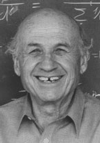FROM: University of California Santa Barbara's Student Newspaper Daily Nexus
Holocaust
Survivor, Nobel Prize Winner:
UCSB's Walter Kohn Laureate Brings Talent, Prestige to
School
By
Sarah Healy - Staff Writer
Wednesday, January 17, 2001
Editor's Note - In 1998, physics Professor Walter Kohn won the first Nobel Prize for a professor at UCSB. This article, the second in a four-part series, looks at Kohn's life and his contributions, both to the field of chemistry and to the school where he has been a professor for the last 22 years.

From his escape of Nazi-controlled Austria, to the transformation of two university physics departments, to a Nobel Prize for chemistry in 1998, UCSB physics Professor Walter Kohn has made his mark on the world.
His impact rubbed off on his colleagues as well - when physics Professor Alan Heeger announced his own Nobel Prize last October, he wore a bolero tie like the one Kohn always wears.
Kohn's Nobel Prize, which was the first won by a professor at UCSB, reflected his skill as a researcher, but also on the school and the institutions whose reputations he helped build.
"It was in some sense an affirmation of something which we knew, that he was an outstanding scientist, that the department was a first-class department," Heeger said. "It was a great place to be."
The journey to Stockholm, Sweden, to retrieve the Nobel Prize was nothing compared to Kohn's journey to the United States and eventually UCSB, which began when Hitler occupied Austria before World War II.
1923-1939: Childhood in Austria
In his early schooling, Kohn took an interest in Latin and Greek. Kohn didn't take an interest in math or science until high school when his physics professor Dr. Emil Nohel, a teaching assistant for Albert Einstein, and his math professor, shared enthusiasm for their subjects with their students. "I was sort of a late bloomer in physics," he said. Nazis later killed both teachers.
The outbreak of the World War II on April 12, 1939, interrupted Kohn's studies, and he escaped Austria on the children's transport - a special program where the English government admitted 10,000 children under the age of 16 it considered in danger.
"There was of course millions and millions of people whose lives were in immediate danger in Europe, and of course virtually all wanted to leave," Kohn said. "But just because there were so many it was very difficult to get permission to go anywhere, to enter a different country ... like my father's difficulty getting permission to leave."
Kohn, like many of the other children, was separated from his parents indefinitely after they died during the Holocaust. "The fact is," he said, "a very small minority of those children ever saw their parents again."
1940-1979: From Farmer to Physicist
When Kohn first arrived in England in 1939, he wanted to pursue a lifestyle as a farmer since jobs for intellectuals were rare. A year later, however, after an adopted family encouraged him to pursue more schooling, he became interested in physics and math.
Soon after, following Winston Churchill's call to "collar the lot," Kohn and other "enemy" immigrants were sent to internment camps. He continued to study from books his school sent him and attend lectures in the camps.
Kohn was finally sent to Canada where, as a refugee, he worked as a lumberjack and used his 20 cents a day to support a habit of buying chemistry and math textbooks. Though encouraged and wanting to study chemistry, his German heritage prevented Kohn from entering a chemistry lab. He studied math for two years at the University of Toronto instead.
His hard work would win him a scholarship to Harvard. In 1960, Kohn went to UC San Diego where he would found the physics department and began research that would earn him the Nobel Prize.
1979-2000: UCSB and the ITP
He was persuaded to leave San Diego for Santa Barbara, however, by what he called "a wonderful challenge" - becoming the founding director of UCSB's new Institute for Theoretical Physics.
The ITP is now home to some of the world's most distinguished physicists and cosmologists, along with a constant stream of visiting scholars. Kohn's directorship got the institute to that point, and the Nobel Prize for his research helped put the ITP and the school on the international map.
His research on the electric structure of alloys led to understanding how electrons are distributed. Before, scientists computed difficult math equations to determine the motion of individual molecules. Kohn simplified this by studying the average number of particles at one point to determine interactions. He inspired the Density Functional Theory, which describes the energy of energy based on spatial density.
Kohn recently dedicated his research to those lost in the Holocaust.
"A person, like myself, who ... loses a lot of really close relatives somehow through accident or whatever, they automatically have a sense of carrying the lost relatives on his shoulders," Kohn said. "I feel like I'm doing this work not only on my own behalf but on the behalf of people who didn't make it."